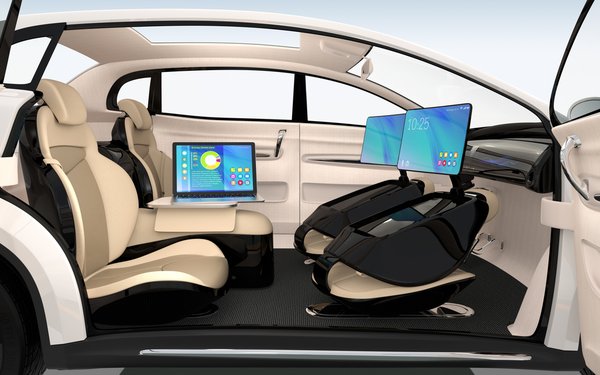
Connected and autonomous vehicles may be getting
a boost by multiple product launches this week and one agency executive says new marketing and advertising opportunities may come with the changing landscape of driving.
Products and services
showcased this week at Mobile World Congress include a 5G-connected self-driving BMW powered by Intel, a self-driving pair of race cars from Roborace and integrated WiFi and live TV streaming in Ford
SUVs, among others.
As vehicles become more connected and driving tasks ultimately shift to automated systems, Viktor Bezic, senior account director at SapientRazorfish, says this will create
a new space for media consumption.
“The self-driving car will effectively create a third space between work and home,” Bezic, who leads the agency’s automotive vertical
practice, told the IoT Daily. “Because of this, the possibilities open up for both work and entertainment.”
advertisement
advertisement
“When windows no longer have to be used for seeing where you are
going, it can effectively be used as another screen,” he said. “New contextually relevant service offerings can be offered.”
While the timeline for bringing the products at
Mobile World Congress to market ranges from this year to 2025, a new study by Deloitte forecasts self-driving vehicles to hit the market in the next four years.
Along with the increase of
automation in driving will come an increase in media consumption in vehicles by drivers not needing to drive their vehicles, according to Deloitte. SapientRazorfish’s Bezic seems to agree.
“With the increasing importance of video online, the autonomous car provides an opportunity that previously didn’t exist, the ability to stream video now that folks no longer need to
look at the road,” Bezic told the Daily. “Recommendations can even provide selected content based on drive times and distance.”
By 2020, connected car services, such
as infotainment and navigation, will generate $40 billion globally, according to Deloitte. By 2030, in-vehicle data consumption will reach .7 Exabytes, or the equivalent of the storage of more than 21
million standard smartphones, per month.
With this new content consumption can come consumer preference and behavioral data, and ultimately, actionable marketing insights.
“It
will be up to marketers and advertisers to work with OEMs to leverage this data to provide contextually relevant content and to also understand the portfolio of services offered so they can see how
and when to engage consumers across these new range of services,” Bezic told the Daily.
Deloitte forecasts that by 2040, at least 70% of vehicles sold in urban areas will be shared or
autonomous.
The trend seems to be toward shared mobility in the long-term, with the majority (80%) of miles traveled by U.S. adults in 2040 to be through shared vehicles.
This outlook
appears to be shared by other executives involved in the autonomous vehicles space.
For example, executives at a recent Future of Transportation event in Boston agreed that autonomous vehicles
will likely be geared toward a public transit structure in the future, as the IoT Daily reported at the time (Self-Driving Cars Hardly Just Around The Corner, Says Boston Future Of
Transportation Panel).
The general consensus of the panel of executives from Toyota, nuTonomy and the city of Boston was that autonomous vehicles are still a long way away from populating
public roads. However, the group said when autonomous vehicles are ultimately on the roads, they will act in a somewhat fixed capacity that move people from select points, rather than a full
door-to-door solution.
For the short-term, Bezic says the in-vehicle battle for advertisers will be for driver and passengers’ attention from their smartphones. Advertisers should look
to partnering with automakers to develop differentiated offerings to replace smartphone use while in vehicles, he said.
“For example, the windshield becomes a new screen for
collaboration, where carpooling co-workers can work on a presentation together or a family can game,” he said. “If cars have multiple passengers, strategies that foster collective
engagement will pull people away from their phones and allow to focus on screens in this new third space.”